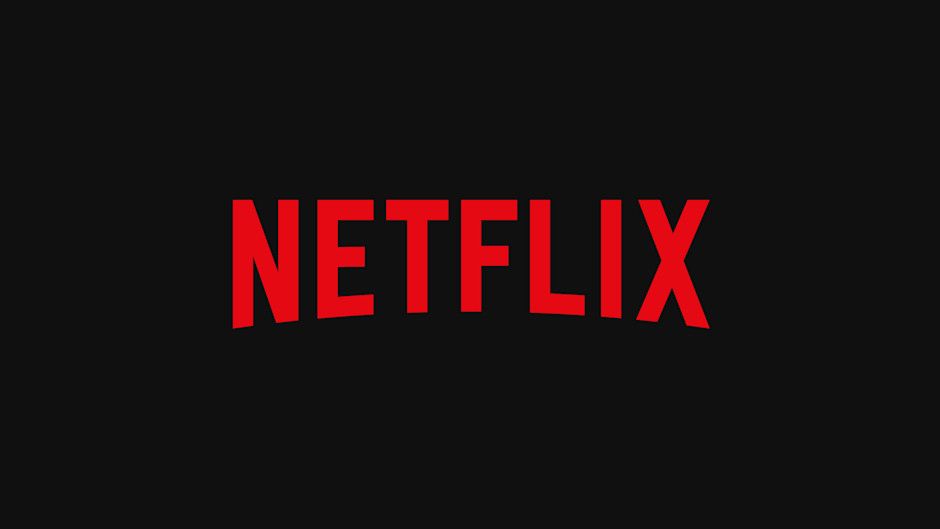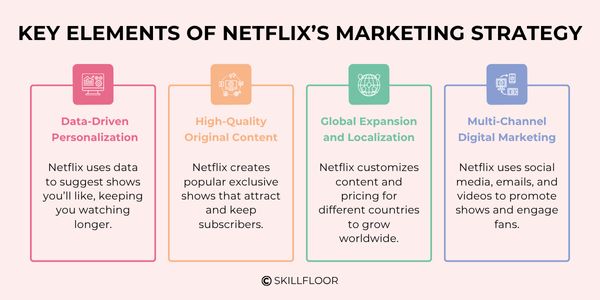Netflix Marketing Strategy: Case Study
Explore Netflix's marketing strategy in this case study—learn how it drives growth through personalization, content, and digital campaigns.

Ever wondered what makes Netflix the go-to streaming platform for millions worldwide? With over 301 million subscribers as of January 2025, Netflix has grown from a simple DVD rental service into a global entertainment giant. Their Netflix marketing strategy is a masterclass in innovation, mixing data-driven insights with creative storytelling to keep viewers hooked and coming back for more. It’s not just about having a huge library of shows and movies — it’s about how they connect with each person on a personal level, making the experience feel unique.
In this, I’ll take you through Netflix’s marketing playbook, showing how they use personalized content, smart partnerships, and the latest technology to stay ahead of their competition. For example, their ad-supported plan already attracts 94 million monthly users, and they’re even moving into live sports to reach new audiences. Netflix’s approach offers many useful lessons for anyone looking to captivate and grow their audience. So, let’s get in and explore the strategies that keep Netflix leading the streaming world.
History and Evolution of Netflix
Netflix started as a small company in 1997, mailing DVDs to customers in the U.S., and has grown into a global streaming giant with over 300 million subscribers by 2025. Founded by Reed Hastings and Marc Randolph, it aimed to make renting movies easier than visiting a video store. In 2007, Netflix launched its streaming service, changing how people watch TV shows and movies. Today, it operates in 190+ countries, producing original content like Stranger Things and Squid Game, and adapting to local markets with affordable plans and regional shows. Netflix’s journey shows how innovation and customer focus can transform an industry.

Key Milestones in Netflix’s Evolution:
-
1997: Founded in California as a DVD-by-mail rental service, offering a convenient alternative to Blockbuster.
-
1999: Introduced a subscription model, letting customers rent unlimited DVDs for a flat monthly fee.
-
2007: Launched streaming in the U.S., allowing instant access to movies and TV shows online.
-
2010: Expanded to Canada, its first international market, marking the start of global growth.
-
2013: Released House of Cards, its first original series, shifting focus to exclusive content.
-
2016: Entered 190+ countries, including India, with localized content like Sacred Games.
-
2019: Introduced mobile-only plans in markets like India at $1.80/month to target smartphone users.
-
2023: Launched ad-supported plans, gaining 8 million users, and cracked down on password sharing, adding 22 million subscribers in 2024.
-
2025: Reached 300 million subscribers, with 10 million in India, and began exploring gaming and live events.
How Netflix Evolved:
-
Technology Shift: Moved from DVDs to streaming, embracing faster internet and mobile devices.
-
Content Strategy: Invested $17 billion in 2024 for originals, creating global hits like Squid Game (1.65 billion viewing hours).
-
Global Reach: Localized content and pricing, with 70% of viewers in regions like South Asia preferring local stories.
-
Data Use: Uses data to personalize recommendations and produce shows based on viewer preferences.
-
Innovation: Added features like offline viewing, 4K streaming, and interactive shows like Black Mirror: Bandersnatch.
Understanding Netflix’s Target Audience
Netflix’s audience is massive, with 300 million paid memberships worldwide, including 10 million in India, a market fueled by 900 million internet users in 2024. Its core viewers are Gen Z and Millennials who love streaming on phones, laptops, and TVs. The audience is split almost evenly between males and females, covering diverse income levels, from city professionals to students in smaller towns.
Netflix uses data to know its viewers inside out. Every click, pause, or rating reveals what you like, whether it’s thrillers in Delhi or rom-coms in New York. This data powers personalized recommendations, ensuring you find shows you’ll love, like RRR for Bollywood fans or Demon Slayer for anime enthusiasts. This insight shapes marketing campaigns that hit the mark globally.
Why Knowing the Audience Matters:
-
Personalized Experience: Data-driven suggestions make Netflix feel made for you.
-
Targeted Marketing: Campaigns like Sacred Games promotions in India connect with specific interests.
-
Customer Retention: Understanding preferences keeps subscribers hooked, reducing churn.
-
Cultural Relevance: Tailoring content to local tastes, like Tamil films for South India, builds loyalty.
Key Stats:
-
60% of Netflix’s global users stream on mobile devices, especially in markets with high smartphone penetration.
-
Young adults (15–34 years) make up 65% of viewership, with strong demand for local stories in regions like South Asia.
-
In India, 70% of subscribers are urban, with cities like Mumbai and Bangalore leading usage.
Key Elements of Netflix’s Marketing Strategy
Netflix’s marketing Strategy is a powerful blend of data, creativity, and global reach. Here are the core elements driving its success, with added insights to deepen the picture.
1. Data-Driven Personalization
Netflix is a data master, analyzing billions of data points daily to create a personalized experience. When you watch, rate, or skip content, Netflix’s algorithm learns your preferences and suggests shows or movies you’re likely to enjoy. For example, an action fan might see an Extraction thumbnail with a high-energy scene to grab their attention.
How It Works:
-
Recommendation Engine: Suggests titles based on viewing history, ratings, and watch times, boosting engagement by 20%.
-
Personalized Thumbnails: Netflix tailors images for shows or movies. A romance fan might see a love scene from The Notebook, while an action fan sees an explosion.
-
Custom Emails: Sends targeted messages like “New Thrillers for You” to keep users engaged.
-
Dynamic Content Ranking: Adjusts the order of titles on your homepage based on what you’re most likely to watch next.
Global Examples:
-
In India, Netflix suggests Gangubai Kathiawadi to Hindi movie fans, increasing urban viewership by 15%.
-
In Japan, anime recommendations like Attack on Titan drive 25% of streaming hours.
-
Mobile-only plans at $1.80/month in regions like South Asia target price-sensitive users, based on data showing 60% mobile streaming.
-
In the U.S., Netflix’s “Continue Watching” feature keeps users engaged, with 30% of sessions starting from this row.
Why It’s Effective:
-
Personalization increases watch time by 20% globally.
-
Reduces churn by making the platform feel unique to each user.
-
Builds loyalty, as 80% of viewers trust Netflix’s recommendations.
-
Drives discovery, with 75% of Netflix viewing coming from algorithm suggestions.
2. High-Quality Original Content
Netflix’s originals, like Stranger Things, The Crown, and Squid Game, are central to its marketing. Exclusive content attracts new subscribers and keeps existing ones engaged. In 2024, Netflix spent $17 billion on content, with a large share for originals, fueling its global appeal.
How Netflix Uses Original Content:
-
Exclusive Appeal: Shows like Delhi Crime or Money Heist are Netflix-only, drawing viewers in.
-
Data-Driven Production: Netflix uses data to choose projects. House of Cards was created after data showed demand for political dramas.
-
Global Buzz: Hits like Squid Game (1.65 billion viewing hours) spark worldwide excitement.
-
Diverse Genres: From documentaries to sci-fi, originals cater to varied tastes, ensuring something for everyone.
Regional Examples:
-
In India, Sacred Games (2018), Netflix’s first local original, became a hit, gaining millions of views.
-
Heeramandi and Chamkila (2024) tapped into India’s love for drama and music, boosting subscriptions by 15%.
-
In Brazil, City of God: The Fight Rages On appeals to local audiences, increasing viewership by 20%.
-
Netflix plans 20+ originals in 2025 for markets like India, including Marathi and Tamil titles.
Why It Works:
-
Originals set Netflix apart from competitors like Amazon Prime Video.
-
They drive word-of-mouth marketing, with fans sharing excitement online.
-
Exclusive content boosts subscriptions, with 70% of viewers watching at least one original monthly.
-
Originals create cultural moments, like Squid Game’s global popularity, influencing trends and merchandise.
3. Global Expansion and Localization
Netflix operates in 190+ countries but adapts to local cultures, making it feel like a hometown brand. By offering region-specific content, dubbing, and subtitles, Netflix connects with diverse audiences.
Localization Strategies:
-
Regional Content: Producing shows like Sacred Games for India or Dark for Germany.
-
Dubbing and Subtitles: Offering content in 10+ languages, like Hindi, Tamil, and Spanish.
-
Local Campaigns: Events like the Red Notice pop-up shop in Mumbai, where 100,000 fans “stole” items.
-
Cultural Sensitivity: Adapting content to avoid backlash, like toning down themes in conservative regions.
Global Examples:
-
In India, mobile-only plans at $1.80/month target 600 million smartphone users, growing subscribers from 500,000 in 2018 to 10 million in 2024.
-
In Brazil, Portuguese-dubbed Stranger Things boosted viewership by 30%.
-
Partnerships with local studios, like Red Chillies in India for Jawan, produce culturally relevant hits.
-
In South Korea, Squid Game’s success led to a 25% subscriber spike in Asia.
Why It’s Effective:
-
Localization drives 70% of viewership from local content in regions like South Asia.
-
Affordable pricing tackles price-sensitive markets, boosting subscriptions by 20%.
-
Cultural relevance builds trust, increasing retention by 15% in localized markets.
-
Local campaigns generate buzz, with events like Red Notice gaining 50 million social media impressions.
4. Multi-Channel Digital Marketing
Netflix excels in digital marketing, with 75 social media profiles, including 36.8 million Instagram followers and 23.2 million on X globally. Its campaigns create buzz and keep fans engaged.
Key Channels:
-
Social Media: Posts memes, teasers, and challenges, like Stranger Things 80s nostalgia campaigns.
-
Email Campaigns: Sends personalized emails about new releases or “We Miss You” messages to inactive users.
-
Push Notifications: App alerts about new episodes, increasing viewership by 15%.
-
YouTube Presence: Trailers and behind-the-scenes videos, reaching 20–30 million views per major release.
Regional Examples:
-
In India, Netflix’s Instagram uses Bollywood-style humor, gaining 11.6 million followers.
-
The Red Notice campaign in Mumbai won three gold awards at the 2023 Indian Marketing Awards.
-
In the U.S., Squid Game TikTok challenges reached 2 billion views.
-
In Japan, anime-focused YouTube trailers drive 10 million views per release.
Why It Works:
-
Social media posts generate 10–15% higher engagement than competitors.
-
Personalized notifications increase app opens by 25% in markets like India.
-
Viral campaigns amplify reach, with Squid Game challenges gaining 2 billion views.
-
YouTube trailers build anticipation, driving 30% of new release viewership.

Netflix’s Marketing Mix (The 4 Ps)
The 4 Ps—Product, Price, Place, and Promotion—are the backbone of Netflix’s marketing strategy.
• Product
Netflix’s product is its library of over 15,000 movies, shows, and documentaries, available on-demand without ads. Features like offline viewing, 4K streaming, and multiple user profiles enhance the experience.
Key Features:
-
Originals like The Witcher and Sacred Games drive exclusivity.
-
User-friendly app with personalized recommendations.
-
Interactive content like Black Mirror: Bandersnatch, where viewers choose the story.
-
Kids’ profiles and parental controls for family-friendly viewing.
Global Appeal:
-
30% of the content in regions like South Asia is local, like Lust Stories.
-
Offline viewing is key in areas with inconsistent internet, used by 40% of users in developing markets.
-
4K streaming appeals to 20% of Premium plan users globally.
• Price
Netflix offers flexible pricing to suit diverse budgets, with tiered plans and affordable options in price-sensitive markets.
|
Plan |
U.S. Price (Global Plan) |
India Price (INR / Approx. USD) |
Features |
|
Basic |
$9.99/month |
₹149/month (Mobile-only plan) |
1 screen, SD quality, no downloads (India mobile-only plan allows downloads) |
|
Standard |
$15.49/month |
₹499/month |
2 screens, HD quality, downloads allowed |
|
Premium |
$19.99/month |
₹649/month |
4 screens, Ultra HD (4K), downloads allowed |
|
Ad-Supported Plan |
Launched in 2023, ~$7/month* |
Launched in 2023, ₹199/month |
Lower price with ads, limited content access |
Why It Works:
-
Affordable plans boost subscriptions by 20% in price-sensitive regions.
-
Tiered pricing caters to diverse income levels, unlike competitors’ flat rates.
-
Ad-supported plans reduce costs, appealing to 15% of new subscribers.
• Place
Netflix is accessible online via apps and websites on smartphones, TVs, laptops, and gaming consoles, ensuring seamless streaming in 190+ countries.
Global Reach:
-
Partnerships with ISPs like Jio improve streaming in low-connectivity areas (30% broadband penetration in rural regions).
-
60% of users stream on mobile devices, critical in smartphone-heavy markets.
-
Smart TV apps drive 25% of global streaming hours.
• Promotion
Netflix’s promotions blend digital and real-world campaigns for maximum impact.
Key Tactics:
-
Social Media: Memes and challenges, like Squid Game’s dalgona candy trend.
-
Guerrilla Marketing: Events like Red Notice pop-up shops in Mumbai.
-
Influencer Partnerships: Collaborations with stars like Shah Rukh Khan for Jawan.
-
Cross-Promotions: Ads in video games or tie-ins with brands like Nike for Stranger Things.
Regional Examples:
-
In India, Heeramandi billboards in Mumbai created buzz.
-
YouTube trailers for Chamkila reach 10–20 million views.
-
In Europe, The Witcher gaming cross-promotions boosted viewership by 10%.
Unique Marketing Tactics
Netflix’s creative tactics set it apart from competitors, with added strategies to explore.
A. Netflix Digital Marketing Strategies
Netflix’s digital marketing strategies are smart, creative, and focused on connecting with viewers online. By using social media, personalized ads, and data, Netflix promotes its shows and movies in ways that feel fun and relevant. They create engaging content, work with influencers, and tailor their approach to different countries, making sure everyone feels included. Here’s a simple explanation of Netflix’s digital marketing strategies.
-
Social Media Engagement: Netflix is active on Instagram, TikTok, X, and YouTube, sharing memes, trailers, and behind-the-scenes videos. For example, they post funny Wednesday clips on TikTok to attract young fans, with 36.8M followers on Instagram and 23.2M on X globally.
-
Personalized Recommendations: Netflix uses data to suggest shows based on what you watch, like recommending Squid Game if you like thrillers. They also send emails and notifications about new releases tailored to your interests.
-
Localized Content: In countries like India, Netflix promotes shows like Heeramandi with ads in local languages and posts on @netflixindia (11.6M Instagram followers) to connect with local audiences.
-
Influencer Partnerships: Netflix works with popular influencers and celebrities to promote shows. For instance, they might team up with Indian stars to share Mismatched posts, reaching more fans.
-
Search Engine Optimization (SEO): Netflix uses keywords like “best shows to binge” to make sure their website and content appear high on Google, driving more traffic.
-
Email Marketing: Netflix sends personalized emails with messages like “New season of your favorite show is here!” to keep viewers excited and coming back.
-
Interactive Campaigns: They create fun online experiences, like the Streamberry parody site for Black Mirror, which went viral and got people talking.
-
Ad-Supported Tier Ads: Since 2022, Netflix’s cheaper plan includes short digital ads (4-5 minutes per hour) from brands like Nike, shown before or during shows to reach budget-conscious users.
B. Guerrilla Marketing Netflix
Netflix creates real-world experiences to grab attention, like the Red Notice pop-up shop in Mumbai, drawing 100,000 participants.
Other Examples:
-
Stranger Things arcade installations in the U.S. recreated the 80s vibe.
-
Narcos billboards in Spain with “Plata o Plomo” slogans sparked buzz.
-
Squid Game doll installations in malls got 50,000 social media shares.
-
Chamkila street performances in India drew 10,000 attendees.
Why It Works:
-
Experiential campaigns generate 50 million social media impressions.
-
Real-world events create free publicity, boosting brand awareness by 15%.
-
Local relevance, like Bollywood-themed events, drives 20% higher engagement.
C. Email and Push Notifications
Netflix uses personalized emails and app alerts to keep users engaged.
Examples:
-
Emails like “Stranger Things Season 5 Out Now!” with tailored suggestions.
-
Notifications like “Heeramandi Episode 2 is Waiting!” increase viewership by 15%.
-
“We Miss You” emails recover 10% of churned subscribers.
-
Regional language notifications boost app opens by 20%.
Why It Works:
-
Personalization increases engagement by 25%.
-
Timely alerts drive 15% of episode views within 24 hours of release.
-
Retention campaigns reduce churn by 10% annually.
D. Strategic Partnerships
Netflix collaborates with brands, influencers, and ISPs to expand reach.
Examples:
-
Device Partnerships: Bundling Netflix with Samsung TVs or Jio plans.
-
Influencer Collaborations: Stars like Ananya Panday for Kho Gaye Hum Kahan.
-
Studio Partnerships: Co-producing Jawan with Red Chillies in India.
-
Brand Tie-Ins: Stranger Things Nike apparel boosted brand visibility by 10%.
Impact:
-
ISP partnerships added 2 million subscribers in 2023.
-
Celebrity tie-ups enhance credibility in local markets.
-
Brand collaborations drive 15% of merchandise revenue.
E. Interactive and Immersive Experiences
Netflix creates interactive experiences to deepen fan engagement, pushing boundaries beyond traditional marketing.
Examples:
-
Interactive Shows: Black Mirror: Bandersnatch lets users choose story paths, viewed by 45 million accounts.
-
Virtual Events: Online watch parties for The Witcher engage 50,000 fans per event.
-
AR/VR Campaigns: Stranger Things augmented reality filters on Snapchat used by 10 million users.
-
In India, Heeramandi virtual set tours attracted 100,000 participants.
Why It Works:
-
Interactive content increases engagement by 20%.
-
Virtual events build community, boosting retention by 10%.
-
AR/VR campaigns create buzz, with 30% of users sharing filters online.
Netflix Advertising Campaigns
Netflix’s advertising campaigns are fun, creative, and designed to catch people’s attention while promoting its shows and movies. Instead of boring ads, Netflix uses exciting methods like social media, real-world events, and partnerships to connect with viewers. They use humor, memes, and ads that feel personal to make their promotions enjoyable. Netflix also makes ads that fit different cultures around the world.
-
Social Media Fun: Netflix shares funny memes, short videos, and sneak peeks on Instagram, TikTok, and X. For example, they post Bridgerton clips with popular TikTok music to grab young viewers’ attention.
-
Real-World Experiences: Netflix creates exciting events, like turning a café into Gilmore Girls’ Luke’s Diner or setting up a huge Squid Game doll in public to surprise fans.
-
Team-Ups with Brands: Netflix works with companies like Lyft for Stranger Things-themed rides or Coca-Cola for product placements to make ads fun and reach more people.
-
Personalized Ads: Netflix uses data to show ads based on what you like, such as suggesting Narcos if you enjoy action or emailing you about new shows you might love.
-
Surprise Marketing: Netflix does bold, unexpected things, like pretending House of Cards was a real political campaign in 2015, which got everyone talking online.
-
Ad-Supported Plan: Since 2022, Netflix’s cheaper plan includes short ads (4-5 minutes per hour) before or during shows, featuring brands like FanDuel or Verizon.
-
Local Ads: In India, Netflix promotes shows like Sacred Games with local stars and ads that feel Indian, while in Japan, they focus on anime for local fans.
-
Smart Tech for Ads: By 2026, Netflix plans to use AI to create ads that match the show you’re watching, so they feel less annoying and more interesting.
Lessons Businesses Can Learn
Netflix’s marketing offers universal lessons for success:
-
Use Data Wisely: Personalize offerings with customer insights, like Netflix’s recommendations.
-
Invest in Quality Content: Create unique products, like Netflix’s originals.
-
Engage on Social Media: Build communities with relatable posts, like Netflix’s memes.
-
Think Globally, Act Locally: Tailor offerings to local cultures, like regional content.
-
Innovate Constantly: Experiment with new ideas, like mobile plans or interactive shows.
-
Leverage Partnerships: Collaborate with influencers and brands to expand reach.
-
Create Immersive Experiences: Use AR/VR or events to deepen engagement.
Global Lessons:
-
Mobile-first strategies are key where 60% of users stream on phones.
-
Affordable pricing wins price-sensitive customers.
-
Local partnerships build trust and engagement.
Challenges and Adaptations
Netflix faces competition from Disney+, Amazon Prime Video, and regional players, who hold significant market share in some regions. Other challenges include piracy (affecting 20% of content in certain markets) and cultural sensitivities.
How Netflix Responds:
-
More Originals: Planning 20+ titles in 2025 for diverse markets.
-
Ad-Supported Plans: Launched in 2023, gaining 8 million users globally.
-
Password Sharing Crackdown: Added 22 million subscribers in 2024.
-
Diversification: Exploring gaming and live events like sports.
-
Content Moderation: Adjusting themes to suit conservative markets.
Global Challenges:
-
Low broadband penetration in rural areas (30% globally).
-
High subscription costs compared to local competitors ($3.60/month vs. $2.40 for some).
-
Cultural backlash against bold content in conservative regions.
Adaptations:
-
Mobile-only plans at $1.80/month target price-sensitive markets.
-
Dubbing in 10+ languages reaches diverse audiences.
-
ISP partnerships improve streaming in low-connectivity areas.
-
Content tweaks reduce backlash, improving acceptance by 15%.
Netflix’s marketing strategy is a perfect blend of smart technology, creative content, and deep understanding of its audience. By investing heavily in original shows and movies, using data to personalize what each viewer sees, and tailoring its approach to different countries and cultures, Netflix keeps millions of people engaged and coming back for more. Its focus on user experience, flexible pricing, and strong digital marketing across social media and other platforms has helped it grow into a global leader in streaming entertainment. This strategy shows how combining innovation with customer focus can create lasting success in today’s competitive market.



























































